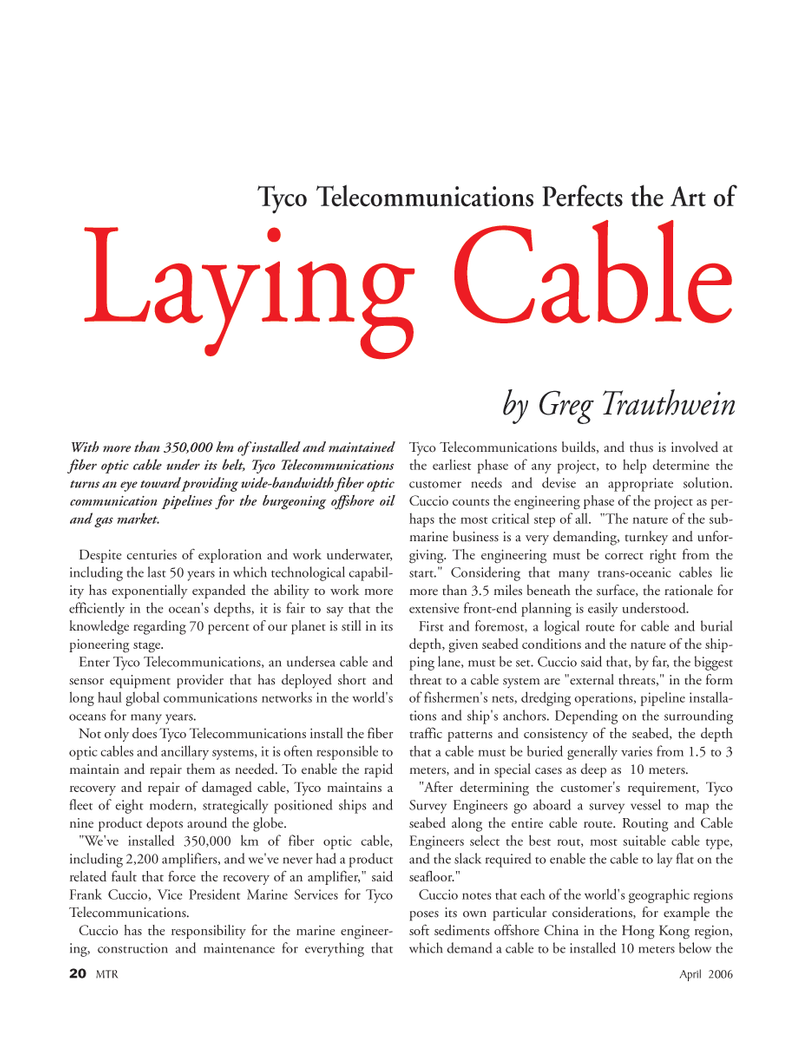
Page 20: of Marine Technology Magazine (April 2006)
The Offshore Technology Edition
Read this page in Pdf, Flash or Html5 edition of April 2006 Marine Technology Magazine
20 MTR April 2006
With more than 350,000 km of installed and maintained fiber optic cable under its belt, Tyco Telecommunications turns an eye toward providing wide-bandwidth fiber optic communication pipelines for the burgeoning offshore oil and gas market.
Despite centuries of exploration and work underwater, including the last 50 years in which technological capabil- ity has exponentially expanded the ability to work more efficiently in the ocean's depths, it is fair to say that the knowledge regarding 70 percent of our planet is still in its pioneering stage.
Enter Tyco Telecommunications, an undersea cable and sensor equipment provider that has deployed short and long haul global communications networks in the world's oceans for many years.
Not only does Tyco Telecommunications install the fiber optic cables and ancillary systems, it is often responsible to maintain and repair them as needed. To enable the rapid recovery and repair of damaged cable, Tyco maintains a fleet of eight modern, strategically positioned ships and nine product depots around the globe. "We've installed 350,000 km of fiber optic cable, including 2,200 amplifiers, and we've never had a product related fault that force the recovery of an amplifier," said
Frank Cuccio, Vice President Marine Services for Tyco
Telecommunications.
Cuccio has the responsibility for the marine engineer- ing, construction and maintenance for everything that
Tyco Telecommunications builds, and thus is involved at the earliest phase of any project, to help determine the customer needs and devise an appropriate solution.
Cuccio counts the engineering phase of the project as per- haps the most critical step of all. "The nature of the sub- marine business is a very demanding, turnkey and unfor- giving. The engineering must be correct right from the start." Considering that many trans-oceanic cables lie more than 3.5 miles beneath the surface, the rationale for extensive front-end planning is easily understood.
First and foremost, a logical route for cable and burial depth, given seabed conditions and the nature of the ship- ping lane, must be set. Cuccio said that, by far, the biggest threat to a cable system are "external threats," in the form of fishermen's nets, dredging operations, pipeline installa- tions and ship's anchors. Depending on the surrounding traffic patterns and consistency of the seabed, the depth that a cable must be buried generally varies from 1.5 to 3 meters, and in special cases as deep as 10 meters. "After determining the customer's requirement, Tyco
Survey Engineers go aboard a survey vessel to map the seabed along the entire cable route. Routing and Cable
Engineers select the best rout, most suitable cable type, and the slack required to enable the cable to lay flat on the seafloor."
Cuccio notes that each of the world's geographic regions poses its own particular considerations, for example the soft sediments offshore China in the Hong Kong region, which demand a cable to be installed 10 meters below the
Tyco Telecommunications Perfects the Art of
Laying Cable by Greg Trauthwein
MTR#3 (17-32).qxd 4/7/2006 11:33 AM Page 20

 19
19

 21
21
